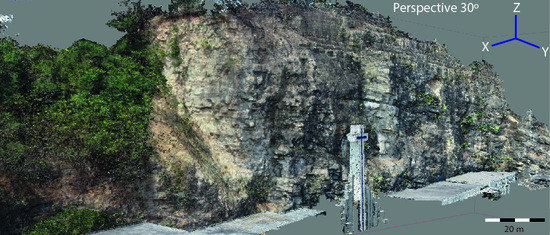Evaluation of Slope Stability Considering the Preservation of the General Patrimonial Cemetery of Guayaquil, Ecuador
Abstract
:1. Introduction.
2. Geographical and Geological Environment
3. Methodology
3.1. First Phase
3.2. Second Phase
3.2.1. Geology
3.2.2. Geomechanical Characterization
Physical–Mechanical Properties
Rock Quality Designation (RQD)
Characteristics of Discontinuities
- -
- the separation between diaclases, which is the average distance between existing fractures in the different sectors of the slope, and
- -
- the state of joints, based on the photographs of the slope acquired with a drone and through in situ observations considering the length of the discontinuity, its opening, roughness, filling, and alteration.
Presence of Water
3.2.3. Geomechanical Characterization
Stability Conditions
SMR
CSMR
Detachment Susceptibility
Calculation of the Safety Factor
4. Results
4.1. Geology
4.1.1. Stratigraphy
4.1.2. Geomechanical Characterization
Physical–Mechanical Properties of Rocks
| 9 | Rock Type | Description | Physical–Mechanical Properties | Cohesion (MPa) | Internal Friction Angle (°) | |
|---|---|---|---|---|---|---|
| Density (g/cm3) | Compression Resistance (MPa) | |||||
| 1 | Calcareous sandstone | Dark gray and medium grained | 2.30 | 117.60 | 18.00 | 38–40 |
| 2 | Silicified shale | Brown and fine grained | 2.29 | 107.50 | 16.60 | 42–46 |
| 3 | Silicified shale | Brown and fine grained | 2.59 | 118.50 | 18.00 | 40–46 |
| 4 | Sandstone | Light gray and fine-to-medium grained | 2.16 | 112.20 | 17.40 | 36–38 |
| 5 | Calcareous sandstone | Light gray and fine-to-medium grained | 2.38 | 116.00 | 14.90 | 40–42 |
| 6 | Sandstone | Gray and medium grained | 2.32 | 111.20 | 15.50 | 38–40 |
RQD
| Zone | Sector | RQD (%) | Classification |
|---|---|---|---|
| 1 | 1 | 45.27 | Poor |
| 2 | 51.05 | Fair | |
| 2 | 3 | 55.51 | Fair |
| 4 | 67.16 | Fair | |
| 5 | 60.50 | Fair | |
| 6 | 71.14 | Fair | |
| 7 | 73.58 | Fair | |
| 8 | 74.80 | Fair | |
| 9 | 65.12 | Fair | |
| 3 | 10 | 66.79 | Fair |
| 11 | 63.19 | Fair |
Characteristics of Discontinuities
| Zone | Sector | Average Separation (m) | Score |
|---|---|---|---|
| 1 | 1 | 0.17 | 8 |
| 2 | 0.17 | 8 | |
| 2 | 3 | 0.32 | 10 |
| 4 | 0.32 | 10 | |
| 5 | 0.26 | 10 | |
| 6 | 0.34 | 10 | |
| 7 | 0.24 | 10 | |
| 8 | 0.31 | 10 | |
| 9 | 0.29 | 10 | |
| 3 | 10 | 0.26 | 10 |
| 11 | 0.38 | 10 |
| Zone | Sector | Discontinuity Length (m) | Gap (mm) | Roughness | Filler | Disturbance |
|---|---|---|---|---|---|---|
| 1 | 1 | 3–10 Score = 10 | 0.1–1 Score = 3 | Undulated Score = 1 | Soft < 5 mm Score = 2 | Moderate Score = 3 |
| 2 | Very altered Score = 1 | |||||
| 2 | 3 | |||||
| 4 | ||||||
| 5 | ||||||
| 6 | Very altered Score = 3 | |||||
| 7 | Very altered Score = 1 | |||||
| 8 | Moderate Score = 3 | |||||
| 9 | Very altered Score = 3 | |||||
| 3 | 10 | None Score = 6 | ||||
| 11 |
Water Presence
| Area | Sectors | Water Flow in the Joints | Score |
|---|---|---|---|
| 1 | 1 | Dry | 15 |
| 2 | Slightly humid | 10 | |
| 2 | 3 | Flowing water | 0 |
| 4 | Humid | 7 | |
| 5 | Dripping | 4 | |
| 6 | Slightly humid | 10 | |
| 7 | 10 | ||
| 8 | Dry | 15 | |
| 9 | 15 | ||
| 3 | 10 | 15 | |
| 11 | 15 |
4.2. Evaluation of Stability
4.2.1. Stability Conditions
| Zone | Sector | RMR (%) | SMR (%) | CSMR (%) | Classification | |
|---|---|---|---|---|---|---|
| SMR | CSMR | |||||
| 1 | 1 | 54 | 44.71 | 45.45 | Fair | Fair |
| 2 | 52 | 41.21 | 43.45 | Fair | Fair | |
| 2 | 3 | 44 | 32.93 | 33.85 | Poor | Poor |
| 4 | 51 | 39.93 | 40.85 | Poor | Poor | |
| 5 | 48 | 36.93 | 37.85 | Poor | Poor | |
| 6 | 56 | 44.93 | 45.85 | Fair | Fair | |
| 7 | 54 | 42.93 | 43.85 | Fair | Fair | |
| 8 | 61 | 49.93 | 50.85 | Fair | Fair | |
| 9 | 59 | 47.93 | 48.85 | Fair | Fair | |
| 3 | 10 | 65 | 52.84 | 54.09 | Fair | Fair |
| 11 | 65 | 52.84 | 54.09 | Fair | Fair | |
4.2.2. Detachment Susceptibility and Safety Factor
| Zone | Sector | Susceptibility: Current Conditions | Susceptibility: Extreme Conditions | Profile | Hypothetical Safety Factor (SF) | Real SF |
|---|---|---|---|---|---|---|
| 1 | 1 | High | High | 7 8 | 0.606 0.681 | 0.996 0.995 |
| 2 | High | High | ||||
| 2 | 3 | High | Very High | 3 4 5 6 | 0.677 0.759 0.690 0.725 | 0.997 0.982 0.989 0.996 |
| 4 | Very High | Very High | ||||
| 5 | High | Very High | ||||
| 6 | High | Very High | ||||
| 7 | High | Very High | ||||
| 8 | High | Very High | ||||
| 9 | High | High | ||||
| 3 | 10 | High | High | 1 2 | 0.831 0.892 | 0.996 0.999 |
| 11 | High | Very High |
5. Interpretation of Results and Discussion
6. Conclusions
7. Recommendations
Author Contributions
Funding
Acknowledgments
Conflicts of Interest
Abbreviations
| SMR | Slope Mass Rating |
| CSMR | Chinese Slope Mass Rating |
| SF | Safety Factor |
| RQD | Rock Quality Designation |
| RMR | Rock Mass Rating |
| F | Factors |
| λ | Condition of Discontinuities |
| DS | Detachment Susceptibility Coefficient |
References
- De Matteis, Á.; Estabilidad de Taludes. Rosario: Facultad de C.S. Exactas, Ingeniería y Agrimensura, Universidad Nacional de Rosario. 2003. Available online: https://www.fceia.unr.edu.ar/geologiaygeotecnia/Estabilidad%20de%20Taludes.pdf (accessed on 25 February 2019).
- Varnes, D.J.; Cruden, D.M. Landslide Types and Processes. Available online: http://onlinepubs.trb.org/Onlinepubs/sr/sr29/29-003.pdf (accessed on 29 December 2018).
- Penning-Rowsell, E.C.; Smith, K. Environmental Hazards: Assessing Risk and Reducing Disaster. Geogr. J. 1993, 159, 349. [Google Scholar] [CrossRef]
- Kresna, B.N.; Bahagiarti, S.; Purwanto, P. Geology and Slope Stability Analysis using Markland Method on Road Segment of Piyungan-Patuk, Sleman and Gunungkidul Regencies, Yogykarta Special Region, Indonesia. Inter. J. Econ. Environ. Geol. 2016, 7, 42–52. [Google Scholar]
- González de Vallejo, L.I.; Ferrer, M.; Ortuño, L.; Oteo, C. Ingeniería Geológica; Prentice Hall-Pearson Educación: Madrid, Spain, 2002; p. 750. [Google Scholar]
- Pérez, E. Estabilidad de Taludes; Canals i Ports Universitat Politècnica de Catalunya: Catalunya, Spain, 2005; p. 61. [Google Scholar]
- Alpízar, A. Metodología de Análisis de Estabilidad de Taludes Para Proyectos Vials; XI Congreso Nacional de Geotecnia: Congeo, Costa Rica, 2012. [Google Scholar]
- Salazar, D.G. Diseño de un Plan Piloto Turístico Educativo Sobre el Cementerio Patrimonial de Guayaquil, Dirigido a los Estudiantes de la Escuela Dr. Avellán Vite de 4to a 7mo año de Educación Básica. Licenciado; Turismo y Hotelería-Universidad de Guayaquil: Guayaquil, Ecuador, 2017. [Google Scholar]
- Guayaquil es mi Destino. Available online: http://www.guayaquilesmidestino.com/ (accessed on 23 December 2018).
- Morante, F.E. Las Zeolitas de la Costa de Ecuador (Guayaquil): Geología, Caracterización y Aplicaciones. Ph.D. Thesis, Ciencias-Universidad Politécnica de Madrid, Madrid, Spain, 2004. [Google Scholar]
- Alemán, A. Informe Geológico de la Cuenca Progreso; Informe no publicado para la Compañía Duke Energy: Guayaquil, Ecuador, 1999. [Google Scholar]
- Núñez del Arco, E. Geología del Ecuador; Escuela Superior Politécnica del Litoral: Guayaquil, Ecuador, 2003; p. 275. [Google Scholar]
- Olsson, A. Tertiary deposits of NO south America and Panamá. 8th Am. Sci. Congr. Washington. Geol. Sci. 1942, 4, 231–287. [Google Scholar]
- Benítez, S.B. Estratigrafía de las formaciones Cayo y Guayaquil en la cordillera Chongón Colonche: Hacia una redefínición. Geocienc. Rev. del CIGMP Guayaquil 1990, 3, 7–11. [Google Scholar]
- Lopez Coronel, M.C. Análisis Estructural de la Cuenca Progreso- Secuencias Paleógenas. Ph.D. Thesis, Ingeniería en Geología-Escuela Superior Politécnica del Litoral, Guayaquil, Ecuador, 2016. [Google Scholar]
- Thalmann, H. Micropaleontology of Upper Cretaceous and Paleoceno in Western Ecuador. Am. Assoc. Pet. Geol. Bull. 1946, 30, 337–347. [Google Scholar]
- Benitez, S. Évolution géodynamique de la province côtière sud-équatorienne au Crétacé supérieur- Tertiaire. Available online: http://geologie-alpine.ujf-grenoble.fr/articles/GA_1995__71__3_0.pdf (accessed on 29 December 2018).
- Centro de Investigaciones y Proyectos Aplicados a la Tierra “CIPAT”. Estudios y Propuestas de Estabilización del Talud en el Cerro del Carmen del Cementerio General; Informe no publicado para la Junta de Beneficencia de Guayaquil realizado por ESPOLTECH E.P.; Guayaquil Charity Board (Junta de Beneficencia de Guayaquil): Guayaquil, Ecuador, 2018. [Google Scholar]
- Li, D.; Wong, L.N.Y. The Brazilian Disc Test for Rock Mechanics Applications: Review and New Insights. Rock Mech. Rock Eng. 2012, 46, 269–287. [Google Scholar] [CrossRef]
- Ma, T.; Peng, N.; Zhu, Z.; Zhang, Q.; Yang, C.; Zhao, J. Brazilian Tensile Strength of Anisotropic Rocks: Review and New Insights. Energies 2018, 11, 304. [Google Scholar] [CrossRef]
- Akazawa, T. New test method for evaluating internal stress due to compression of concrete: The splitting tension test. J. Jpn. Soc. Civ. Eng 1943, 29, 777–787. [Google Scholar]
- Carneiro, F.L.L.B. A new method to determine the tensile strength of concrete. In Proceedings of the 5th Meeting of the Brazilian Association for Technical Rules, Lisbon, Portugal, 16 September 1943; pp. 126–129. [Google Scholar]
- Stagg, K.G.; Zienkiewicz, O.C. Rock Mechanics in Engineering Practice; Wiley: New York, NY, USA, 1968; p. 442. [Google Scholar]
- Deere, D.U.; Deere, D.W. Rock Quality Designation (RQD) after twenty years; U.S. Army Engineer Waterways Experiment Station: Vicksburg, MS, USA, 1988; p. 101. [Google Scholar]
- Priest, S.D.; Hudson, S.D. Discontinuity spacings in rock. Inter. J. Rock Mech. Min. Sci. Geomech. Abstr. 1976, 13, 135–148. [Google Scholar] [CrossRef]
- Suarez, J. Deslizamientos y Estabilidad de Taludes en Zonas Tropicales; Instituto de Investigaciones sobre Erosión y Deslizamientos: Bucaramanga, Colombia, 1998; p. 550. [Google Scholar]
- Blanco, R. Estudios y Propuestas de Estabilización del Cerro Las Cabras; Informe no publicado para la Municipalidad de Durán realizado por CIPAT-ESPOL; Duran Municipality: Duran, Ecuador, 2015. [Google Scholar]
- Anbalagan, R.; Chakraborty, D.; Kohli, A. Landslide hazard zonation (LHZ) mapping on meso-scale for systematic town planning in mountainous terrain. J. Sci. Ind. Res. 2008, 67, 486–497. [Google Scholar]
- Romana, M. A geomechanical classification for slopes: Slope Mass Rating: Principles, Practice and Projects. In Rock Testing and Site Characterization; Elsevier: Amsterdam, The Netherlands, 1993. [Google Scholar]
- Chen, Z. Recent Developments in Slope Stability Analysis. Inter. Soc. Rock Mech. Rock Eng. 1995, 8, 1041–1048. [Google Scholar]
- Romana, M. The Geomechanical Classification SMR for Slope Correction. Inter. Soc. Rock Mech. Rock Eng. 1995, 8, 1085–1092. [Google Scholar]
- Romana Ruiz, M.; Serón Gáñez, J.B.; Montalar Yago, E. La clasificación geomecánica SMR: Aplicación, Experiencias y Validación; V Simposio Nacional sobre Taludes y Laderas Inestables: Madrid, Spain, 2001. [Google Scholar]
- Bieniawski, Z.T. Engineering Rock Mass Classifications: A Complete Manual for Engineers and Geologists in Mining, Civil, and Petroleum Engineering; John Wiley and Sons: New York, NY, USA, 1989. [Google Scholar]
- Anbalagan, R. Landslide hazard evaluation and zonation mapping in mountainous terrain. Eng. Geol. 1992, 32, 269–277. [Google Scholar] [CrossRef]
- Nicholson, D.; Hencher, S. Assessing the Potential for Deterioration of Engineered Rockslopes. Available online: https://www.researchgate.net/publication/209804864_Assessing_the_potential_for_deterioration_of_engineered_rockslopes (accessed on 29 December 2018).
- Román, A.Q.; Feoli-Boraschi, S. Comparación de la Metodología Mora-Vahrson y el Método Morfométrico para Determinar Áreas Susceptibles a Deslizamientos en la Microcuenca del Río Macho, Costa Rica. REVGEO 2018, 1, 17–45. [Google Scholar]
- Barrantes, G.; Barrantes, O.; Núñez, O. Efectividad de la metodología Mora-Vahrson modificada en el caso de los deslizamientos provocados por el terremoto de Cinchona, Costa Rica. Revista Geográfica de América Central 2011, 2, 141–162. [Google Scholar]
- Sánchez, C.; Sánchez, A. Evaluación de Amenazas Geodinámicas en el Entorno de la Actividad Minera en la Concesión Minera Palacios. Ph.D. Thesis, Escuela Superior Politécnica del Litoral, Guayaquil, Ecuador, 2018. [Google Scholar]
- Morgenstern, N.R.; Price, V.E. The Analysis of the Stability of General Slip Surfaces. Géotechnique 1965, 15, 79–93. [Google Scholar] [CrossRef]
- Melentijevic, S. Estabilidad de Taludes en Macizos Rocosos con Criterios de Rotura no Lineales y Leyes de Fluencia no Asociada. Ph.D. Thesis, Universidad Politécnica de Madrid, Madrid, Spain, 2005. [Google Scholar]
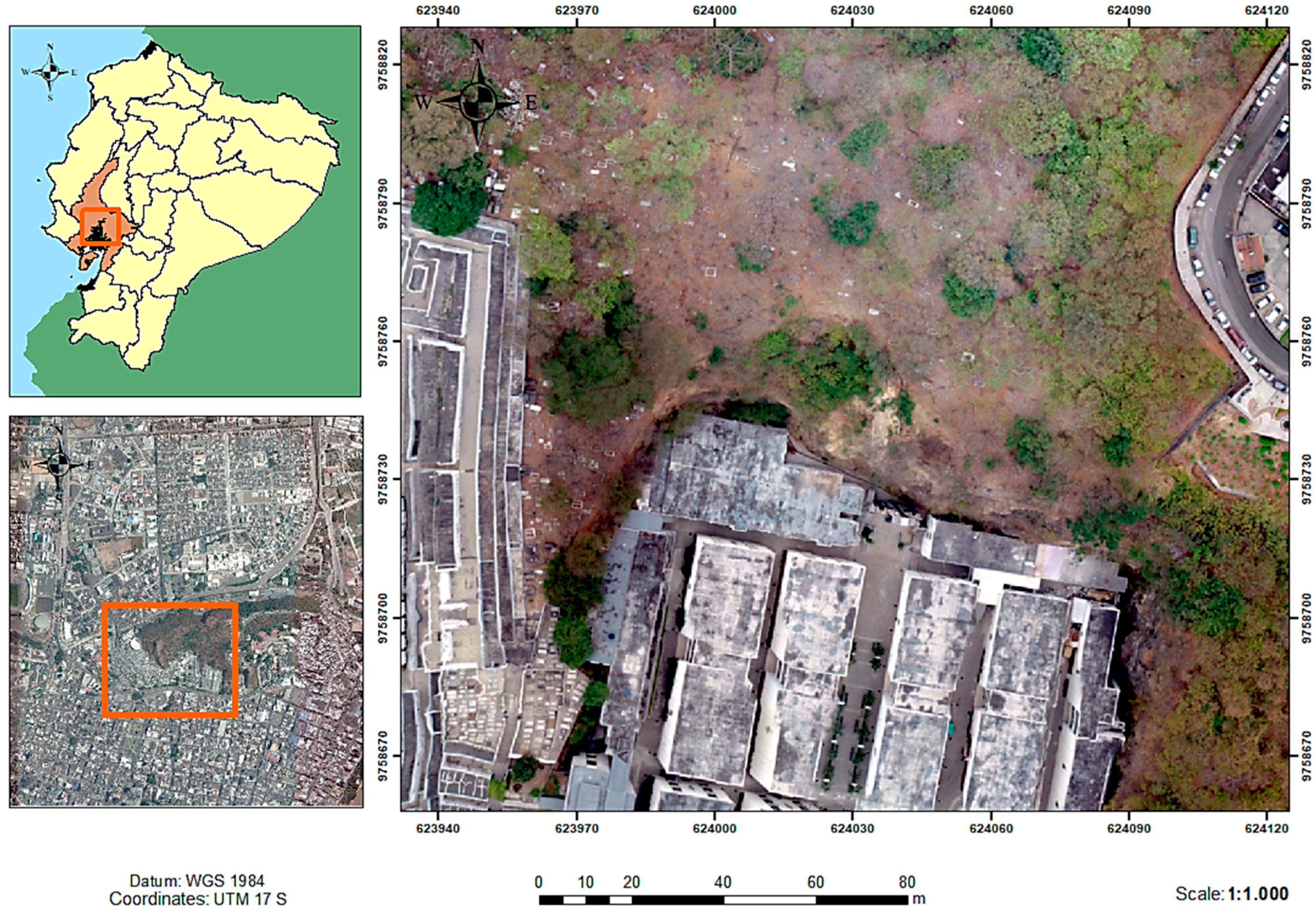
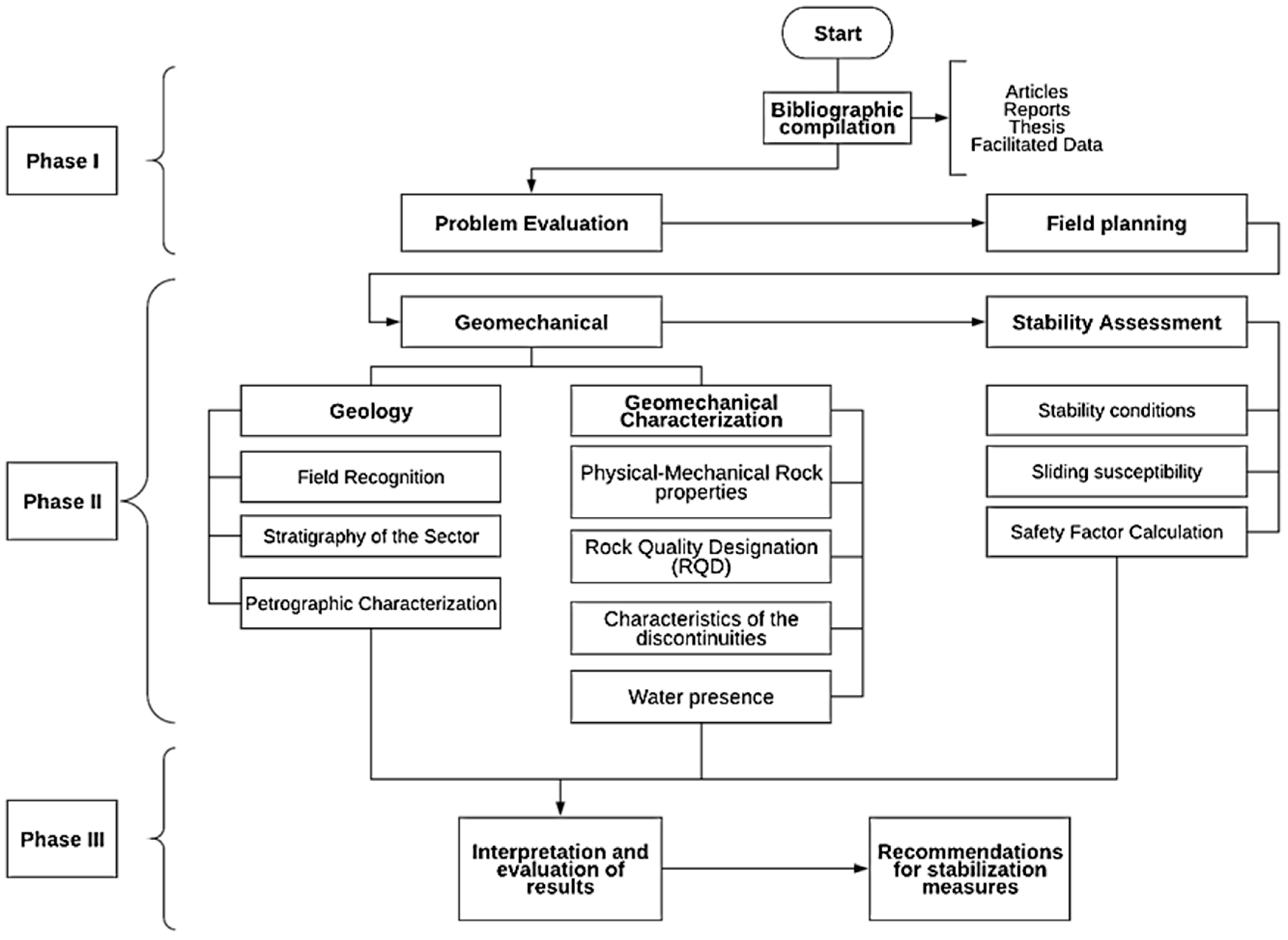
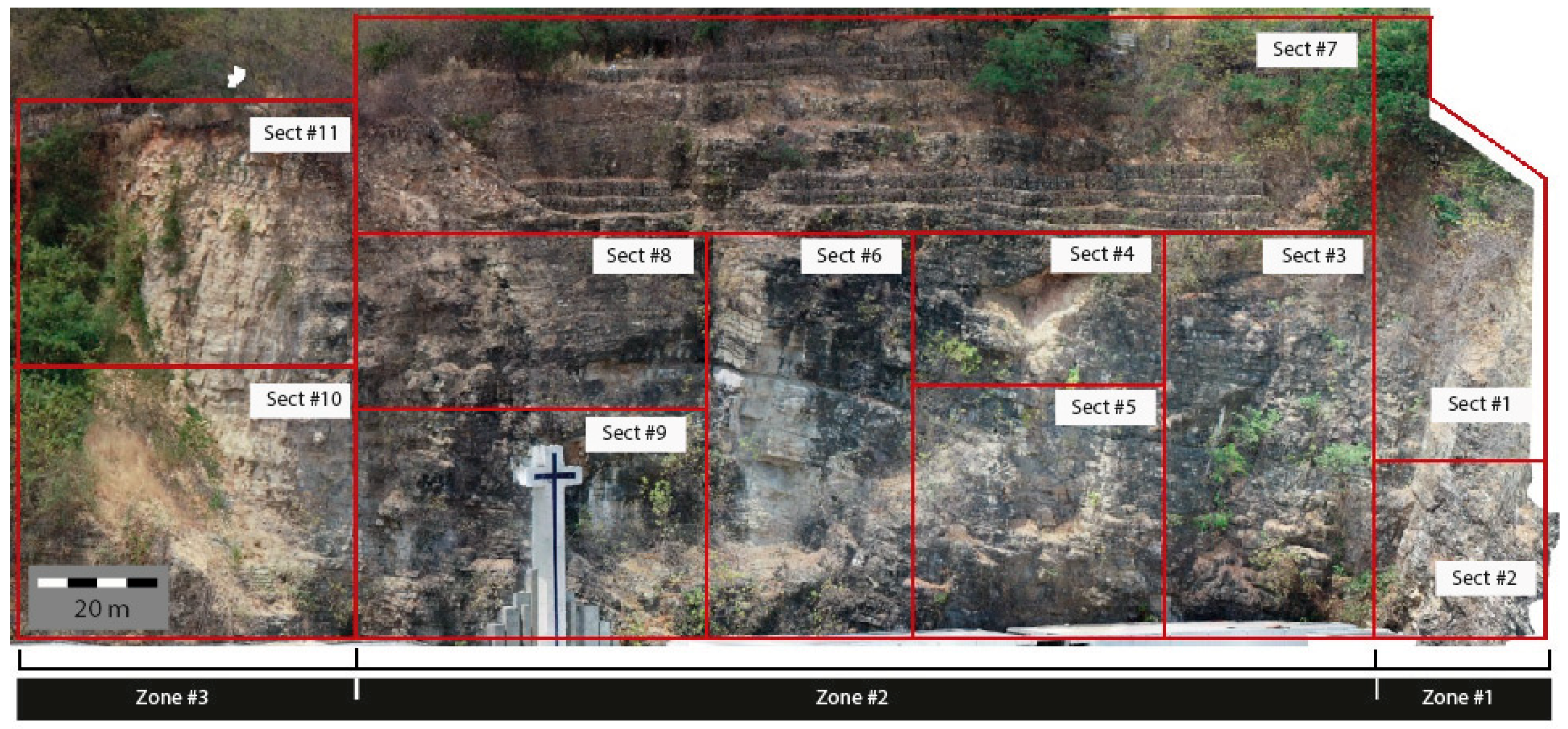

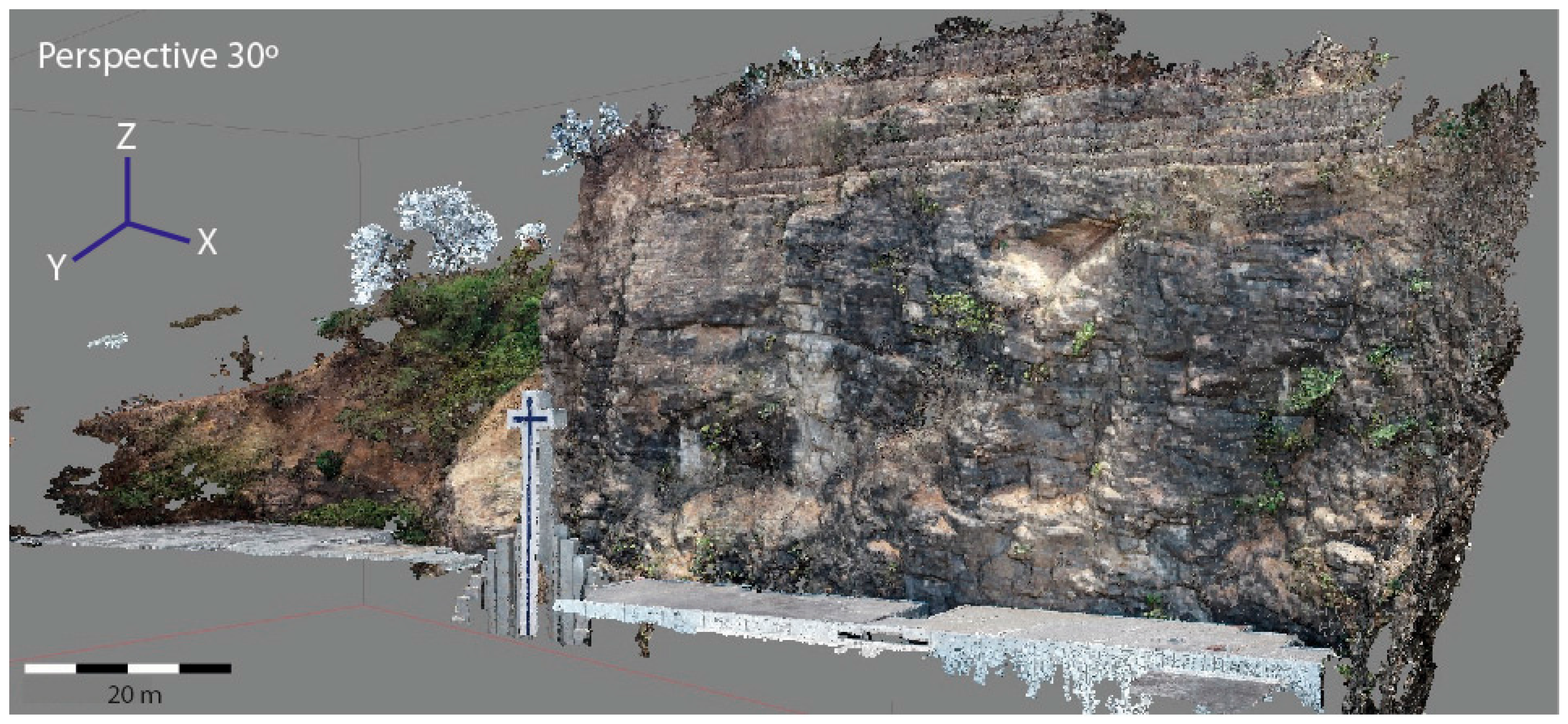
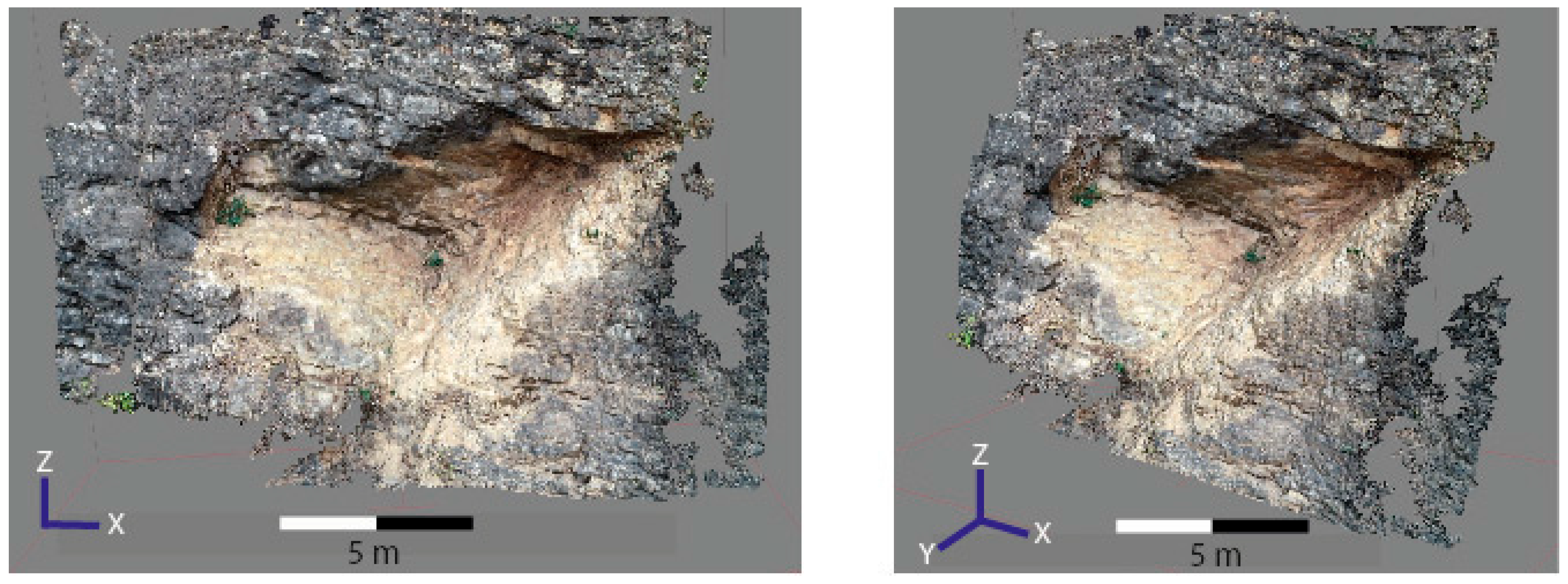
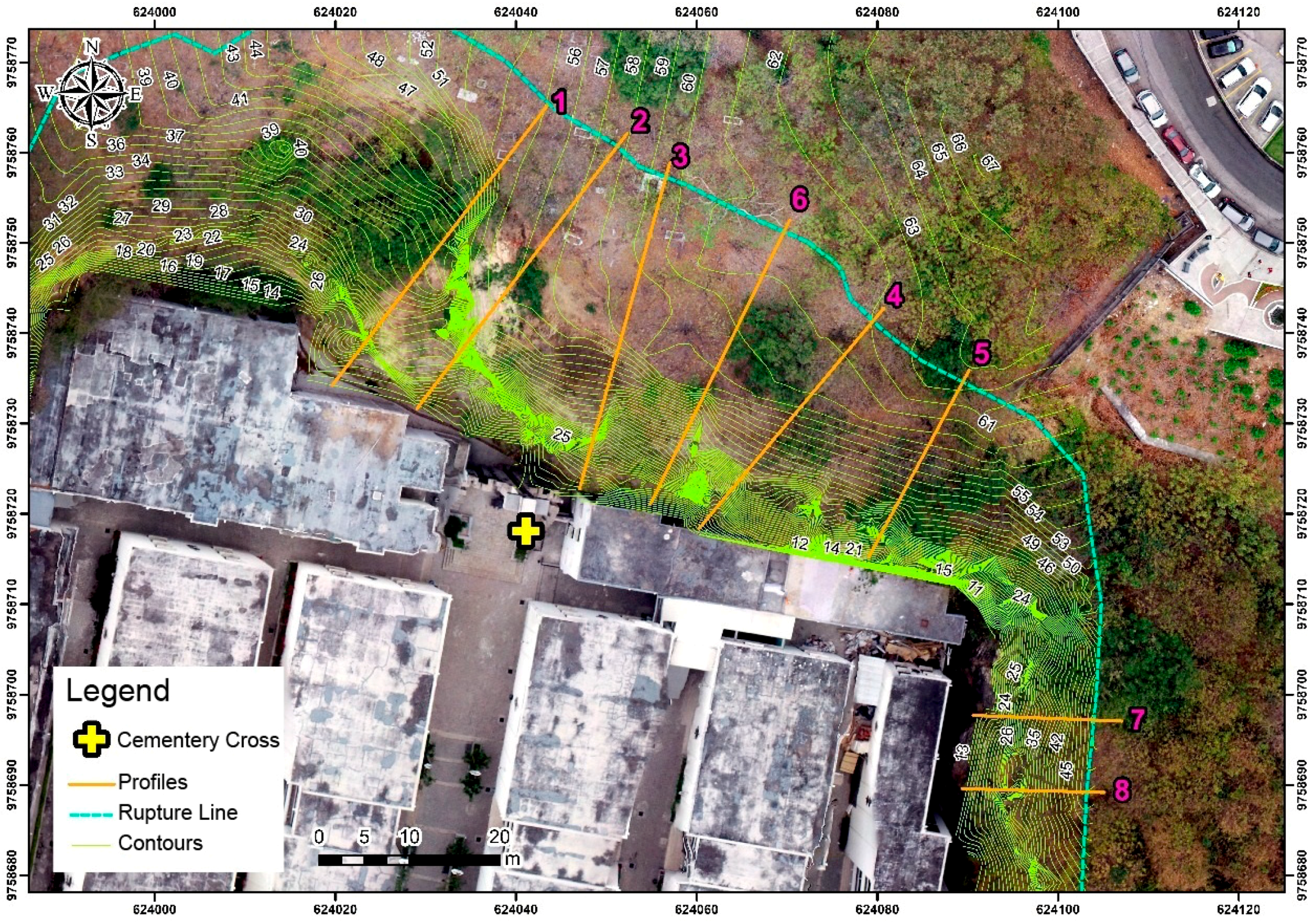
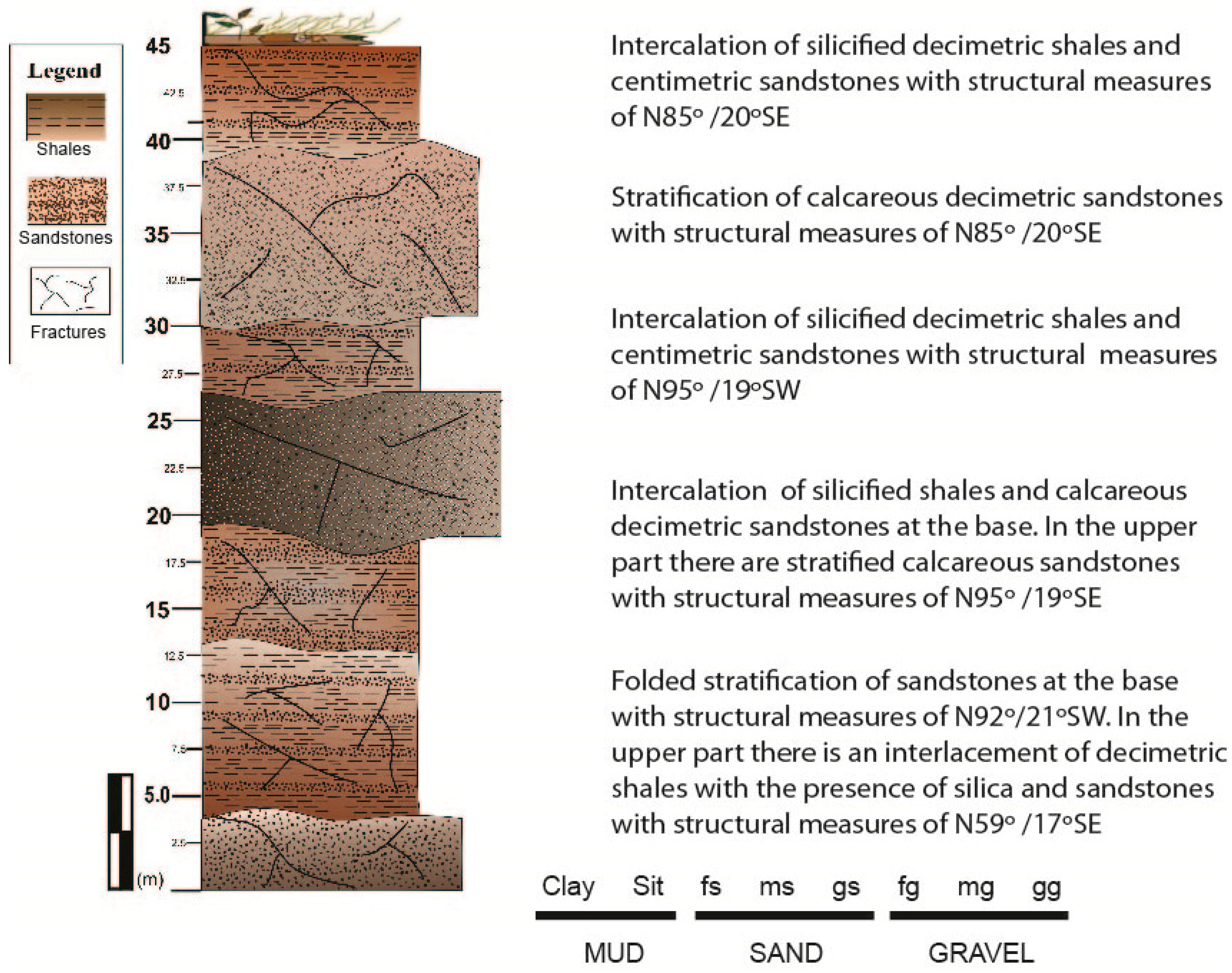

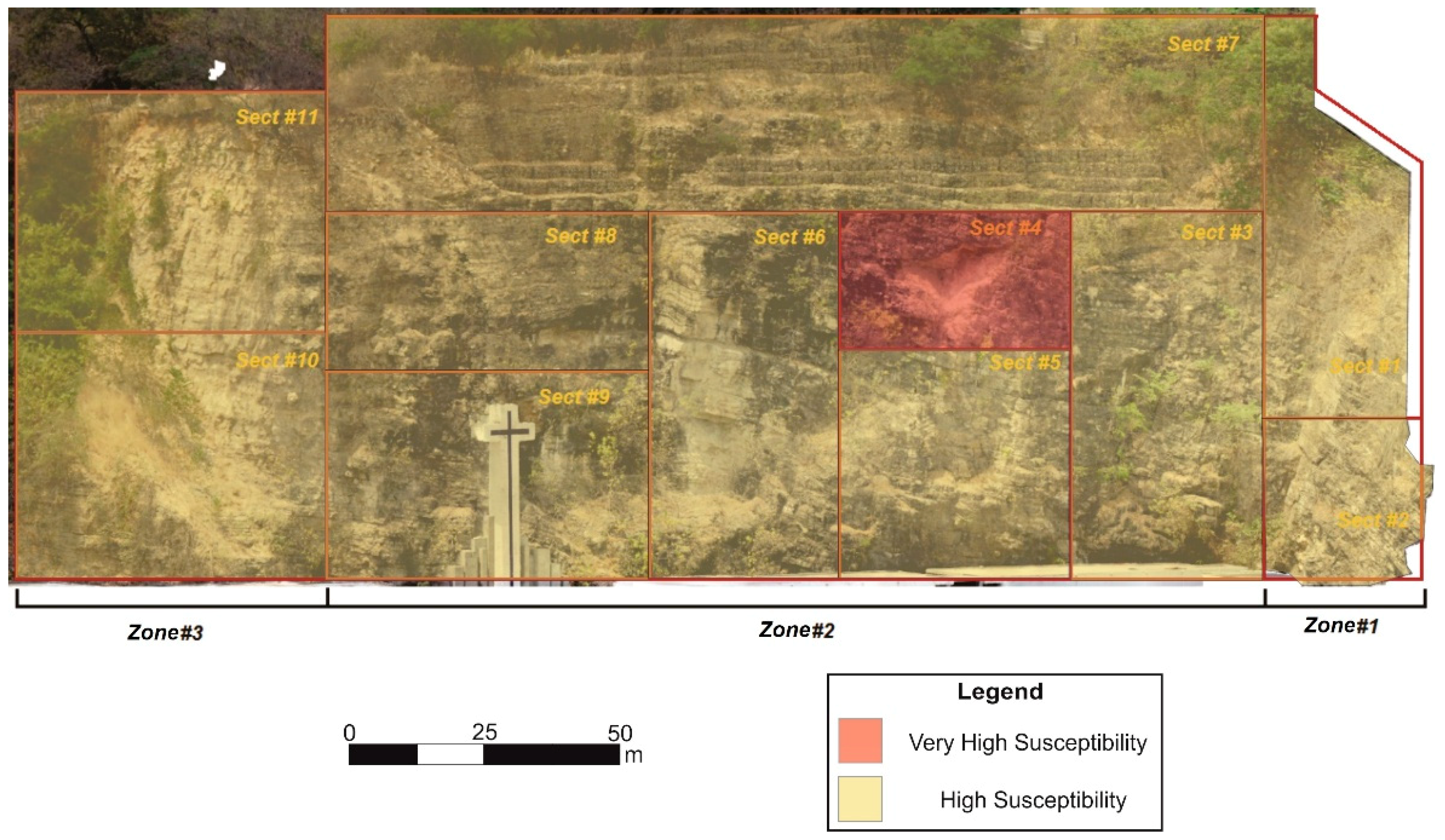
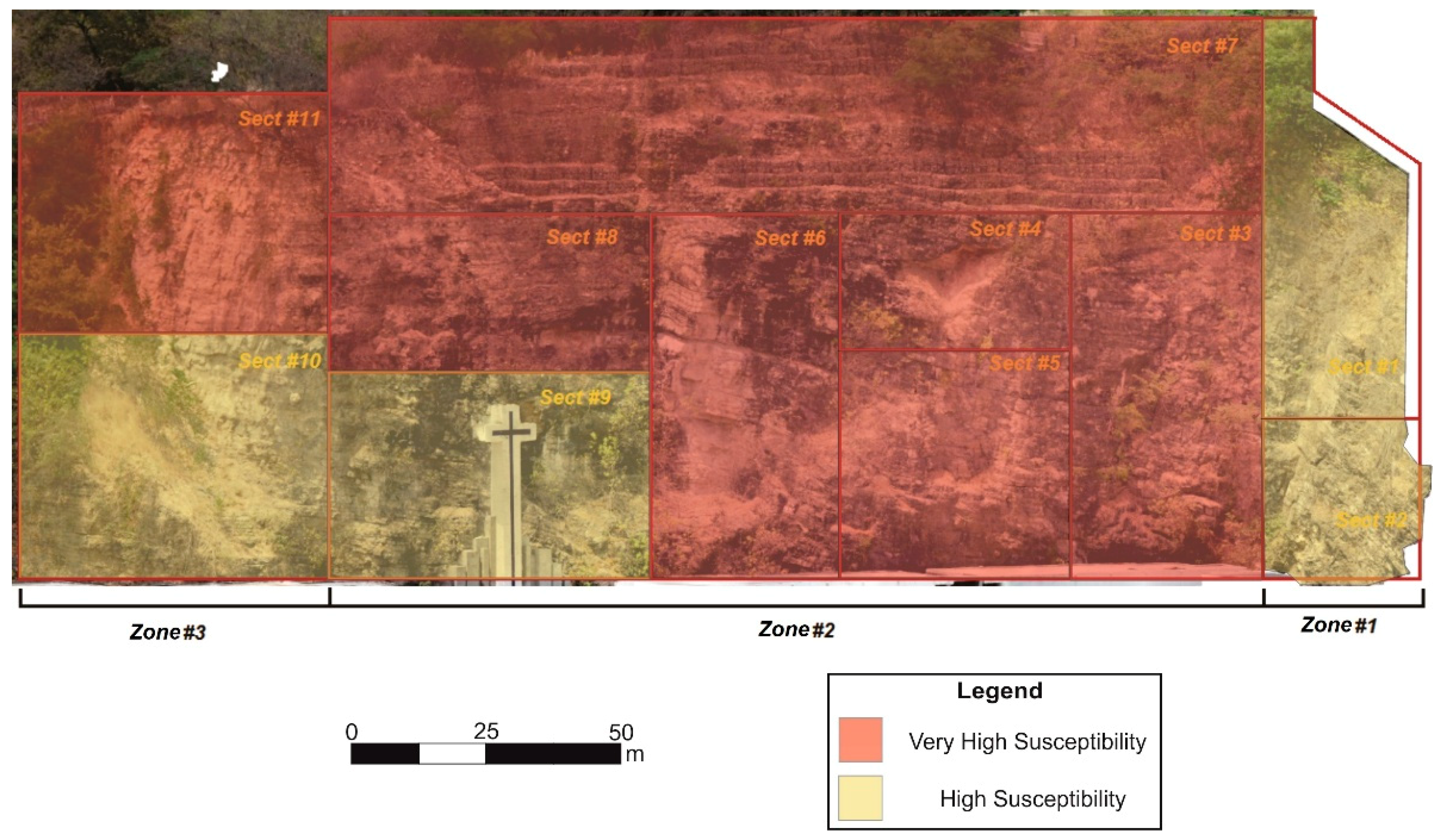

| RQD (%) | Rock Quality |
|---|---|
| 25 | Very Poor |
| 25–50 | Poor |
| 50–75 | Fair |
| 75–90 | Good |
| 90–100 | Very Good |
| 1 | Rock Matrix Resistance (MPa) | Point Load Test | >10 | 10–4 | 4–2 | 2–1 | Simple Compression | ||
| Simple Compression | >250 | 250–100 | 100–50 | 50–25 | 25–5 | 5–1 | <1 | ||
| Score | 15 | 12 | 7 | 4 | 2 | 1 | 0 | ||
| 2 | RQD | 90–100% | 75–90% | 50–75% | 25–50% | <25% | |||
| Score | 20 | 17 | 13 | 6 | 3 | ||||
| 3 | Separation between diaclases | >2 m | 0.6–2 m | 0.2–0.6 m | 0.06–0.2 m | <0.06 m | |||
| Score | 20 | 15 | 10 | 8 | 5 | ||||
| 4 | State of the discontinuities | Length of the discontinuity | <1 m | 1–3 m | 3–10 m | 10–20 m | >20 m | ||
| Score | 6 | 4 | 2 | 1 | 0 | ||||
| Gap | None | <0.1 mm | 0.1-1.0 mm | 1-5 mm | >5 mm | ||||
| Score | 6 | 5 | 3 | 1 | 0 | ||||
| Roughness | Very Rough | Rough | Slightly rough | Undulate | Soft | ||||
| Score | 6 | 5 | 3 | 1 | 0 | ||||
| Filler | None | Hard-filled < 5 mm | Hard-filled > 5 mm | Soft-filled < 5 mm | Soft-filled > 5 mm | ||||
| Score | 6 | 5 | 3 | 1 | 0 | ||||
| Disturbance | Unaltered | Slightly altered | Moderately altered | Very altered | Decomposed | ||||
| Score | 6 | 5 | 3 | 1 | 0 | ||||
| 5 | Groundwater | Overall status | Dry | Slightly humid | Humid | Dripping | Flowing water | ||
| Score | 15 | 10 | 7 | 4 | 0 | ||||
| Rock Mass Quality | |||||||||
| Grade | I | II | III | IV | V | ||||
| RMR | 100–81 | 8–61 | 60–41 | 40–21 | <20 | ||||
| Quality | Very Good | Good | Fair | Poor | Very Poor | ||||
| Adjustment factors for the orientation of the joints () | ||||||
| Case | Very Favorable | Favorable | Fair | Unfavorable | Very Unfavorable | |
| P T | >30° | 30–20° | 20–10° | 10–5° | <5° | |
| P/T | 0.15 | 0.40 | 0.70 | 0.85 | 1.00 | |
| P | <20° | 20–30° | 30–35° | 35–45° | >45° | |
| 0.15 | 0.40 | 0.70 | 0.85 | 1.00 | ||
| T | 1 | 1 | 1 | 1 | 1 | |
| P | >10° | 10–0° | 0° | 0° to −10° | <−10° | |
| T | <110° | 110–120° | >120° | - | - | |
| P/T | 0 | −6 | −25 | −50 | −60 | |
| Adjustment Factor according to the Excavation Method (F4) | ||||||
| Method | Natural Slope | Precut | Soft Blasting | Blasting or mechanical excavation | Poor blasting | |
| F4 | +15 | +10 | +8 | 0 | −8 | |
| Stability Classes | ||||||
| Classes | V | IV | III | II | I | |
| SMR | 0–20 | 21–40 | 41–60 | 61–80 | 81–100 | |
| Description | Very Poor | Poor | Fair | Good | Very Good | |
| Stability | Totally unstable | Unstable | Partially stable | Stable | Totally Stable | |
| Break | Large breaks through continuous planes or mass | Joints or large wedges | Some joints or many wedges | Some blocks | None | |
| Treatment | Re-excavation | Correction | Systematic | Occasional | None | |
| P: Flat break T: Break by rollover | : Slope direction : Joint Direction : Dip of the slope : Dip of the joints | |||||
| Condition of Discontinuities | |
|---|---|
| 1.0 | Faults, long and weak joints filled with clays. |
| 0.9–0.8 | Stratification plans, large-scale joints with the presence of water. |
| 0.7 | Tightly linked joints and stratification planes |
| Main Parameters | Score Assigned in the Detachment Susceptibility Analysis (DS) |
|---|---|
| Lithology | Up to 4.0 |
| Geological structure | Up to 4.0 |
| Morphometry and height | Up to 6.0 |
| Discontinuity and key blocks | Up to 6.0 |
| Water | Up to 6.0 |
| Vegetable cover | Up to 4.0 |
| Seismic | Up to 4.0 |
| Weathering Rank | Up to 4.0 |
| Susceptibility Category | Detachment Susceptibility Coefficient (DS) | Observations |
|---|---|---|
| I | Very low susceptibility (DS < 8.0) | Stable conditions |
| II | Low susceptibility (DS between 8 and 15) | Stable conditions; monitoring is required |
| III | Medium susceptibility (DS between 15 and 21) | Predominantly stable conditions; systematic monitoring is required |
| IV | High susceptibility (DS between 21 and 28) | Potentially unstable conditions |
| V | Very high susceptibility (DS > 28) | Unstable conditions |
© 2019 by the authors. Licensee MDPI, Basel, Switzerland. This article is an open access article distributed under the terms and conditions of the Creative Commons Attribution (CC BY) license (http://creativecommons.org/licenses/by/4.0/).
Share and Cite
Morante, F.; Aguilar, M.; Ramírez, G.; Blanco, R.; Carrión, P.; Briones, J.; Berrezueta, E. Evaluation of Slope Stability Considering the Preservation of the General Patrimonial Cemetery of Guayaquil, Ecuador. Geosciences 2019, 9, 103. https://doi.org/10.3390/geosciences9030103
Morante F, Aguilar M, Ramírez G, Blanco R, Carrión P, Briones J, Berrezueta E. Evaluation of Slope Stability Considering the Preservation of the General Patrimonial Cemetery of Guayaquil, Ecuador. Geosciences. 2019; 9(3):103. https://doi.org/10.3390/geosciences9030103
Chicago/Turabian StyleMorante, Fernando, Maribel Aguilar, Gonzalo Ramírez, Roberto Blanco, Paúl Carrión, Josué Briones, and Edgar Berrezueta. 2019. "Evaluation of Slope Stability Considering the Preservation of the General Patrimonial Cemetery of Guayaquil, Ecuador" Geosciences 9, no. 3: 103. https://doi.org/10.3390/geosciences9030103
APA StyleMorante, F., Aguilar, M., Ramírez, G., Blanco, R., Carrión, P., Briones, J., & Berrezueta, E. (2019). Evaluation of Slope Stability Considering the Preservation of the General Patrimonial Cemetery of Guayaquil, Ecuador. Geosciences, 9(3), 103. https://doi.org/10.3390/geosciences9030103






